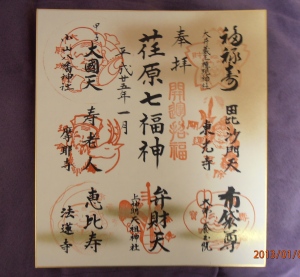The 7 Lucky Gods pilgrimage is a traditional way to start the new year. There are 24 different routes in Tokyo, and I’m sure many, many more throughout the country. I first did one three or four years ago, and chose to do the one known as the Yamate course, which is in Meguro and supposed to be the oldest. I’m going to do that one again tomorrow, but after I met a couple doing my local one, Ebara, (one of two in Shinagawa) on January 1st I became curious about it and found some information on the ward office website. Thanks to the joys of jet lag, I woke up early on Wednesday morning and since it was such a lovely day I decided to do it. I took the train to Oimachi, where the pilgrimage starts (though you can do it from the other end of the route, as the couple I met were doing).
The first stop was a tiny Shinto shrine called Oi Zao Gongen Jinja (大井蔵王権現神社).
 The man in the small office gave me a far better map than the one I had downloaded from the ward office website. I bought a large card with the names of all seven shrines and temples (and their deities) on it, and he told me that if I collected a stamp at every stop I could get a small wooden plaque (called an ema or 絵馬) at the last one. I bought a very small plaque of the god of that shrine; Fukurokuju, god of good luck and longevity:
The man in the small office gave me a far better map than the one I had downloaded from the ward office website. I bought a large card with the names of all seven shrines and temples (and their deities) on it, and he told me that if I collected a stamp at every stop I could get a small wooden plaque (called an ema or 絵馬) at the last one. I bought a very small plaque of the god of that shrine; Fukurokuju, god of good luck and longevity:
 As I left he encouraged me ‘gambatte kudasai’ (頑張ってください), roughly translated as ‘please do your best’ and something you hear on a daily basis before all kinds of endeavours. I vowed to do my best (gambarimasu! / 頑張ります!) and set off. Now, when I say I set off, what I actually did was head back to the main road because I had convinced myself that the route went along there (it was probably wishful thinking). I have to be clear right away that I am very bad at reading maps, apparently it’s spacial brain thing, but I frequently resort to trying to turn a map round to line it up with my surroundings and I have pretty much no sense of direction. I’m sure you have already realised, then, that heading back to the main road was not the thing to do, and so I spent some minutes wandering around, before going back to the road the shrine was on and continuing along there.
As I left he encouraged me ‘gambatte kudasai’ (頑張ってください), roughly translated as ‘please do your best’ and something you hear on a daily basis before all kinds of endeavours. I vowed to do my best (gambarimasu! / 頑張ります!) and set off. Now, when I say I set off, what I actually did was head back to the main road because I had convinced myself that the route went along there (it was probably wishful thinking). I have to be clear right away that I am very bad at reading maps, apparently it’s spacial brain thing, but I frequently resort to trying to turn a map round to line it up with my surroundings and I have pretty much no sense of direction. I’m sure you have already realised, then, that heading back to the main road was not the thing to do, and so I spent some minutes wandering around, before going back to the road the shrine was on and continuing along there.
After about ten minutes I reached the second stop, this time a Buddhist temple called Toko-ji (東光寺).
This was the least interesting of all the places I visited, and hardly anyone was there. There were a number of dog statues, which made me wonder if there was any particular connection and if people somehow could bury their pets here, but I can’t find any information about that, although I did discover that the god of toilets is enshrined here. When I asked the woman in the booth she stamped my card for me, sold me a small ema of the god enshrined there, Bishamonten, god of success and good luck, and gave me some candy so I could continue to do my best.
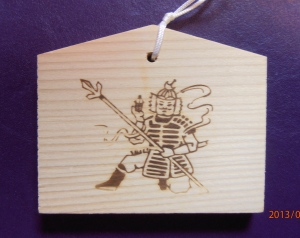 The walk to the next stop was much longer and took about twenty-five minutes. It was quite a circuitous route, and for a while went along the road next to the shinkansen (bullet train) tracks. There was something satisfying about following an old pilgrimage route while the most modern of Japan’s trains glided past. It was also around this time that I really noticed just how hilly Shinagawa is.
The walk to the next stop was much longer and took about twenty-five minutes. It was quite a circuitous route, and for a while went along the road next to the shinkansen (bullet train) tracks. There was something satisfying about following an old pilgrimage route while the most modern of Japan’s trains glided past. It was also around this time that I really noticed just how hilly Shinagawa is.
The third stop was also a Buddhist temple, and my favourite so far. It also had the longest name: Yogyoku-in Nyorai-ji (養玉院・如来寺).
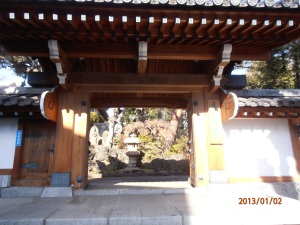
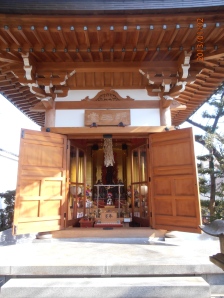 There were a few people there; the approach to the temple wound up a small hill and felt very peaceful. An elderly man was there with his small grandson, showing him how to worship. The god there is Hotei, god of good luck, matchmaking and fertility.
There were a few people there; the approach to the temple wound up a small hill and felt very peaceful. An elderly man was there with his small grandson, showing him how to worship. The god there is Hotei, god of good luck, matchmaking and fertility.
 Now, I was already feeling a little map-challenged, and so asked the women at the temple how long it would take to get to the next stop, and where I went from there. They told me it was quite a long walk, about twenty minutes, but this is where I went badly wrong and did a looping detour which added some time to my trek. I left the temple, pausing to listen to someone ring the bell in the tower,
Now, I was already feeling a little map-challenged, and so asked the women at the temple how long it would take to get to the next stop, and where I went from there. They told me it was quite a long walk, about twenty minutes, but this is where I went badly wrong and did a looping detour which added some time to my trek. I left the temple, pausing to listen to someone ring the bell in the tower,
 lined my map up, thought I knew where I was going . . . and then spent the next fifteen minutes getting lost. It was especially annoying since I knew that once I found the next place I was on home turf and knew the area much better. I just had to get there. Finally I admitted defeat and asked an elderly woman and her daughter who were out for a walk. The daughter did not seem to like me stopping them to ask but her mother started to give me directions. Another woman, out walking her impeccably-groomed dog, also stopped to help and marvelled at me doing something that most Japanese people don’t do. Once I knew generally where I was going I set off, now accompanied by the woman and her dog, and for a few minutes had one of those odd English and Japanese conversations with her. She asked me about where I was from, how long I’d been in Japan, and threw in words in English when the mood took her. The hill got steeper, I don’t think she wanted to go in that direction anyway, and so we shook hands, wished each other a Happy New Year and I carried on. At the top of the hill I stopped to look at my map again and this time another Japanese woman asked me (in perfect English) if she could help. Apparently I was already on track, it was just a walk straight down the other side of the hill, but it was nice to have confirmation.
lined my map up, thought I knew where I was going . . . and then spent the next fifteen minutes getting lost. It was especially annoying since I knew that once I found the next place I was on home turf and knew the area much better. I just had to get there. Finally I admitted defeat and asked an elderly woman and her daughter who were out for a walk. The daughter did not seem to like me stopping them to ask but her mother started to give me directions. Another woman, out walking her impeccably-groomed dog, also stopped to help and marvelled at me doing something that most Japanese people don’t do. Once I knew generally where I was going I set off, now accompanied by the woman and her dog, and for a few minutes had one of those odd English and Japanese conversations with her. She asked me about where I was from, how long I’d been in Japan, and threw in words in English when the mood took her. The hill got steeper, I don’t think she wanted to go in that direction anyway, and so we shook hands, wished each other a Happy New Year and I carried on. At the top of the hill I stopped to look at my map again and this time another Japanese woman asked me (in perfect English) if she could help. Apparently I was already on track, it was just a walk straight down the other side of the hill, but it was nice to have confirmation.
In something of a giddy mood I reached the next stop, Kamishinmei Tenso-jinja (上神明天祖神社), a Shinto shrine where the only goddess of the 7 lucky gods, Benten, is enshrined.
 It’s not a very good photo, but it was the busiest of all the places I visited, and a lot of people were praying. (When I was first in Japan I attended a church in Yokohama which was on the tourist trail, so on Sunday mornings, as we came out of church we were often photographed by Japanese sightseers, sometimes even in church, and I didn’t like it. Years later, I love to visit shrines and temples, but they are principally places of worship, and I’ll only get close if no one is praying.) So, I got the stamp on my card, bought my ema
It’s not a very good photo, but it was the busiest of all the places I visited, and a lot of people were praying. (When I was first in Japan I attended a church in Yokohama which was on the tourist trail, so on Sunday mornings, as we came out of church we were often photographed by Japanese sightseers, sometimes even in church, and I didn’t like it. Years later, I love to visit shrines and temples, but they are principally places of worship, and I’ll only get close if no one is praying.) So, I got the stamp on my card, bought my ema
 and looked around a bit. The main hall was very busy, with people lined up waiting to pray. There was a recording of ceremonial music playing and off to one side some men were burning last year’s rice straw rope called ‘shimenawa’ (標縄).
and looked around a bit. The main hall was very busy, with people lined up waiting to pray. There was a recording of ceremonial music playing and off to one side some men were burning last year’s rice straw rope called ‘shimenawa’ (標縄).
When I left the shrine I felt truly confident of my route for the first time on the pilgrimage, since now it was a walk straight down my local shopping street. I quickly arrived at the fifth stop, Horen-ji (法蓮寺), another Buddhist temple. It was the biggest of the seven, and also probably the most recently (re)built.
 Ironically it seems to be the most impressive from the photo, but it felt the least spiritual. There was hardly anybody there, and since I’ve been there before I got my stamp, bought my ema of Ebisu, the god of commerce, and carried on.
Ironically it seems to be the most impressive from the photo, but it felt the least spiritual. There was hardly anybody there, and since I’ve been there before I got my stamp, bought my ema of Ebisu, the god of commerce, and carried on.
 The walk to the next place was another quite long trek, but now I was in my own neighbourhood so I knew exactly where I was. It felt odd to walk past the end of my road and keep going, and being so close to home made me realise just how tired I was. I had bought some sushi as I walked along the shopping street after the last temple and was looking forward to getting home and having some lunch.
The walk to the next place was another quite long trek, but now I was in my own neighbourhood so I knew exactly where I was. It felt odd to walk past the end of my road and keep going, and being so close to home made me realise just how tired I was. I had bought some sushi as I walked along the shopping street after the last temple and was looking forward to getting home and having some lunch.
Anyway, I plodded on, and on the way to the next stop I saw a tiny neighbourhood shrine in the corner of a small carpark.
 Just a few metres further on I arrived at Maya-ji (摩耶寺), another Buddhist temple, where Jurojin, god of longevity and happiness is enshrined.
Just a few metres further on I arrived at Maya-ji (摩耶寺), another Buddhist temple, where Jurojin, god of longevity and happiness is enshrined.

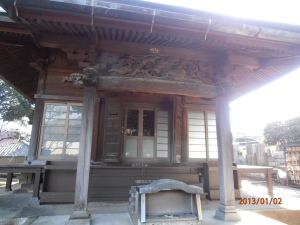 The people here were lovely, and after I stamped my card they gave me a cup of hot sweet sake and I had a short rest. While I was sitting and sipping on my sake I got talking to a couple who had just started the pilgrimage, so this was only their second stop. I proudly showed them my almost-completed card. They said they do a different pilgrimage route every New Year, and that so far they’ve done somewhere between 10 and 20. I was happy to hear that their favourite so far had been the Meguro pilgrimage; that’s the one I’m doing tomorrow.
The people here were lovely, and after I stamped my card they gave me a cup of hot sweet sake and I had a short rest. While I was sitting and sipping on my sake I got talking to a couple who had just started the pilgrimage, so this was only their second stop. I proudly showed them my almost-completed card. They said they do a different pilgrimage route every New Year, and that so far they’ve done somewhere between 10 and 20. I was happy to hear that their favourite so far had been the Meguro pilgrimage; that’s the one I’m doing tomorrow.
When I’d finished my sake I had a quick look round and took the photos above. I bought the ema of Jurojin
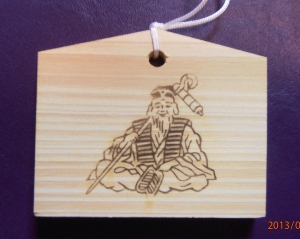 and was offered some more sake, cold this time, which everyone who had worshipped was given. When I declined they gave me the little cup anyway so I could take it home. They were so kind and I think I liked them the best. It’s also only about five minutes away from where I live and I’d never been there before, so I’m glad I found it.
and was offered some more sake, cold this time, which everyone who had worshipped was given. When I declined they gave me the little cup anyway so I could take it home. They were so kind and I think I liked them the best. It’s also only about five minutes away from where I live and I’d never been there before, so I’m glad I found it.
So, the last stop, a Shinto shrine, and it was just round the corner, but it was at the top of a steep hill, which was the last thing I wanted to see at that point. The crows were making a fearful racket in the tree tops as I reached Koyama Hachiman Jinja (小山八幡神社), where the last god, Daikokuten, god of rich harvests, is enshrined.
 I got my last stamp and the man in the booth took the card to add the final stamp which would certify that I had completed the pilgrimage. For one awful moment I thought he was going to keep the card, but he returned it to me with the ema of all the lucky gods in their treasure boat (takarabune or 宝船). I bought the little ema of Daikokuten
I got my last stamp and the man in the booth took the card to add the final stamp which would certify that I had completed the pilgrimage. For one awful moment I thought he was going to keep the card, but he returned it to me with the ema of all the lucky gods in their treasure boat (takarabune or 宝船). I bought the little ema of Daikokuten
 and assurances that my year would indeed be very lucky I went home with sore feet but a huge sense of accomplishment.
and assurances that my year would indeed be very lucky I went home with sore feet but a huge sense of accomplishment.




